Background
Kokanee are the landlocked form of the Sockeye Salmon. While the Sockeye Salmon mature in the ocean and migrate into streams, Kokanee mature in lakes or reservoirs and migrate into tributaries in the fall to spawn. Kokanee were first introduced as fingerlings to California waters in 1941. The purpose of this introduction was to provide a sport fish suitable for reservoirs with water level fluctuations.
The Kokanee life cycle in California reservoirs is typically 2-3 years, with older fish occasionally observed in the sport fishery or during spawning surveys. Kokanee prefer water temperatures from 10-13° C, but can tolerate temperatures up to 15° C. Kokanee feed almost exclusively on zooplankton.
Kokanee provide a popular fishery when they fish reach a size acceptable to anglers. Kokanee can be sensitive to density-dependent effects, with compensatory reductions in size observed when natural reproduction exceeds carrying capacity (intraspecific competition) or growth is impacted due to competition with other species (interspecific competition), such as Wakasagi (Hypomesus nipponensis) and Opossum Shrimp (Mysis spp.). Currently, CDFW plants approximately 750,000 fingerling-sized Kokanee in 15 reservoirs annually. Seven other reservoirs are managed with self-sustaining Kokanee populations.
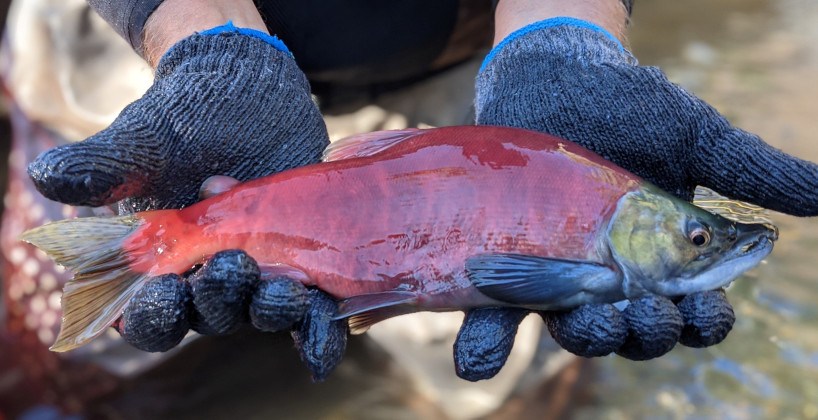 Male Kokanee displaying spawning coloration. CDFW photo by Gabriel Singer.
Male Kokanee displaying spawning coloration. CDFW photo by Gabriel Singer.
Identification
Non-spawning phase
- Bright silver sides with dark blue to green backs
- Occasionally have fine dark spots on back and tail fin
- Deeply forked tail (distinguishes Kokanee from rainbow trout)
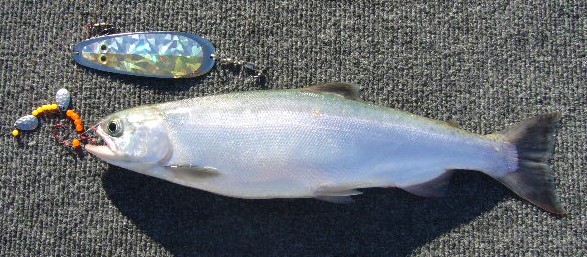 CDFW photo by Kyle Murphy.
CDFW photo by Kyle Murphy.
Spawning phase
- Bodies of both males and females turn bright red while the head and tail remain olive green
- Males have a pronounced hook jaw (kype) and humped back
- Females have relatively little change in shape
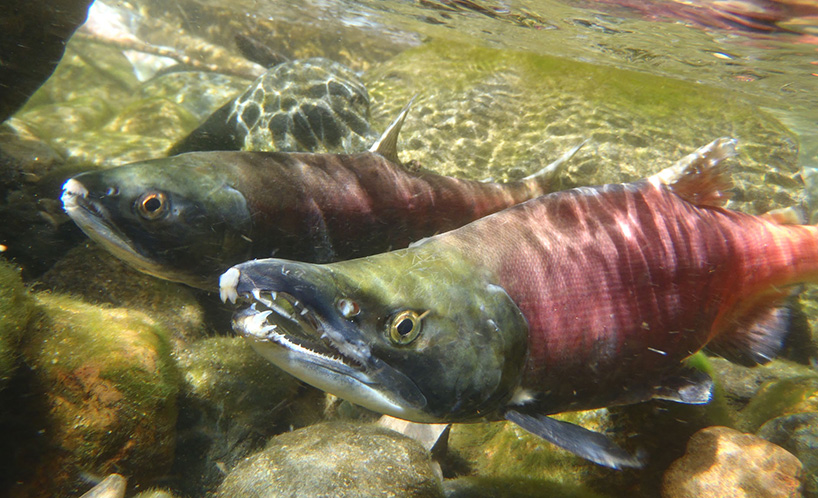 CDFW photo by Andrew Hughan.
CDFW photo by Andrew Hughan.
Size Range
- Average size 10-12 inches
- Can reach sizes up to 20 inches in some reservoir conditions
Distinguishing Kokanee from Chinook Salmon
- Kokanee have more, densely spaced gill rakers than Chinook Salmon. This gill raker morphology is why Kokanee are regarded as efficient planktivores.
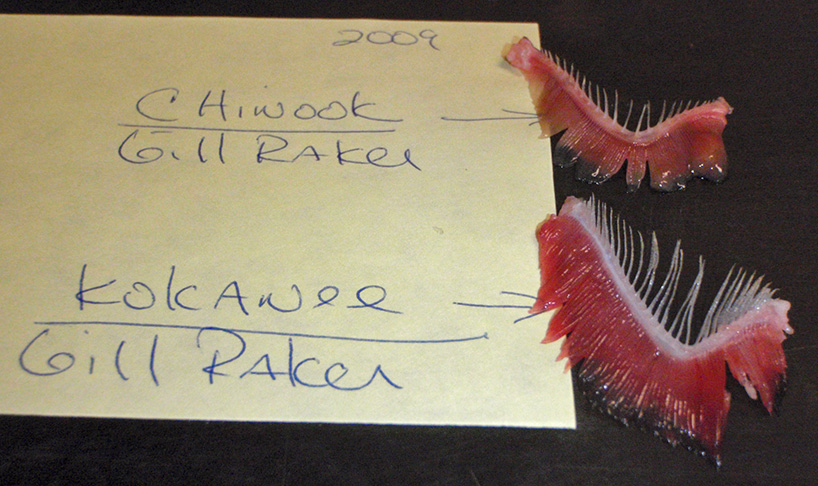 Chinook Salmon (top) and Kokanee (bottom) gill rakers. CDFW photo by Kyle Murphy.
Chinook Salmon (top) and Kokanee (bottom) gill rakers. CDFW photo by Kyle Murphy.
Distribution
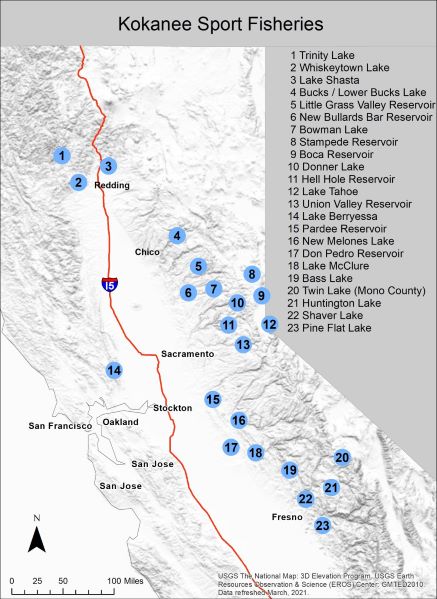 Map showing the location of Kokanee waters in California.
Map showing the location of Kokanee waters in California.
Angling
Where to Fish
Kokanee frequent open water, thus anglers have the most success fishing from a boat. Kokanee are a schooling fish and can be found in various locations in a reservoir. Because they prefer cool water temperatures, they can be found near the water surface in early season and low light periods and will descend in depth as water temperature increases and lakes stratify during the summer months. During the few weeks in the fall before the Kokanee move into the tributaries to spawn, they will congregate in dense schools near the mouths of tributaries.
How to Fish
Anglers usually begin targeting Kokanee in the spring, with the peak fishing effort occurring during the summer months. Trolling is the most common method used. While trolling, anglers typically use downriggers, to reach the depth that Kokanee congregate. Some anglers use leadcore line or lead weights to access the various depths Kokanee are found. Due to their aggressive action when hooked, anglers will often use an ultra-light action rod. Many manufactures make rods especially for targeting Kokanee.
Popular Kokanee lures include small spinners, soft plastic tubes often called “hoochies” or “squids”, and small spoons. Kokanee will hit a variety of lure colors, but the most common colors used are pink and orange. Anglers often attach a Dodger or other flasher just ahead of the lure. The use of a dodger or flasher assists in attracting Kokanee to the lure. The most successful anglers will tip their lures with a kernel of white “shoepeg” corn. This corn is often scented to increase fish attraction.
Trolling speed can be critical to angling success. The typical trolling speed for Kokanee is between 0.8 and 1.5 mph.
Regulations
See interactive map with freshwater sport fishing regulations.
1.57. LANDLOCKED SALMON. Landlocked salmon includes kokanee and landlocked Chinook Salmon.
5.41. LANDLOCKED SALMON
(a) Open season: All year
(b) Daily bag limit: Five
(c) Possession limit: Ten
(d) Size limit: None
Exceptions: Bucks Lake (Plumas Co.), Pardee Lake (Amador Co.), New Bullards Bar Reservoir (Yuba Co.), and Trinity Lake (Trinity Co.), which shall be subject to the following limits:
(a) Daily bag limit: Ten
(b) Possession limit: Twenty
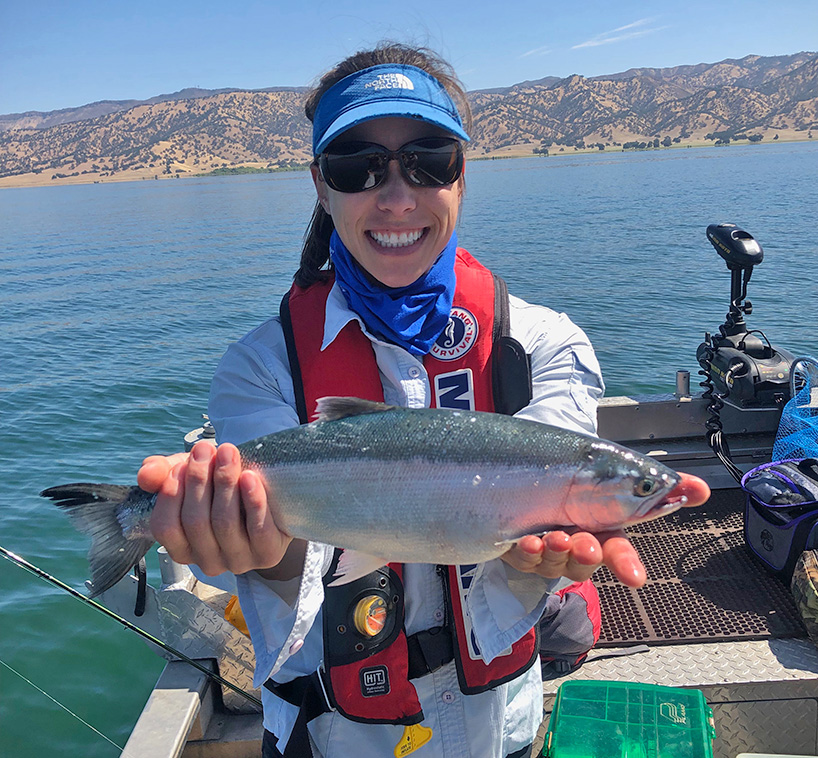 Adult Kokanee caught by trolling with a downrigger. CDFW photo by Max Fish.
Adult Kokanee caught by trolling with a downrigger. CDFW photo by Max Fish.
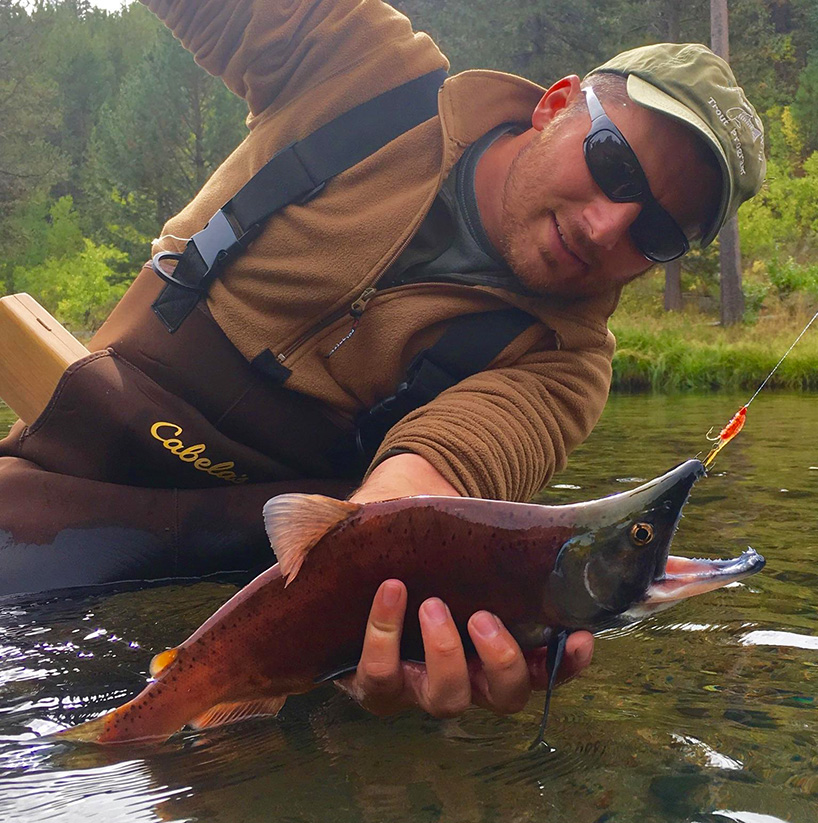 Adult male Kokanee in spawning form. CDFW photo by Adam Koons.
Adult male Kokanee in spawning form. CDFW photo by Adam Koons.
Reports